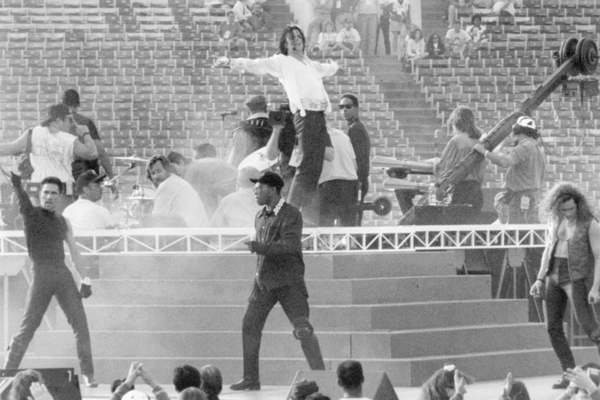In the beginning, Super Bowl halftime performances consisted mostly of marching bands and professional extreme stunt acts. But with their yearly audience rapidly increasing, the National Football League (NFL) recognized the need for bigger and better halftime shows. Soon, they began enlisting famous artists to take the stage halfway through the game – a decision that forever changed how viewers engage with halftime performances. Here are six Super Bowl performances we’ll never forget.
Super Bowl I

A list of the best Super Bowl halftime performances would not be complete without the very first one. On January 15, 1967, marching bands from Grambling State University and the University of Arizona took the field. During their performance they formed an outline of the United States on the field, and were joined by trumpeter Al Hirt and the Three Stooges. Spectators were also treated to 300 pigeons, 10,000 balloons, and a demonstration by the Bell Rocket Air Men, who soared through the air propelled by hydrogen peroxide.
Super Bowl XXV
On January 26, 1992, the theme for Super Bowl XXV was “A Small World Salute to 25 Years of the Super Bowl” in honor of a quarter of a century of professional football championship games. New Kids on the Block were the featured act, with 3,500 local children from several different ethnic backgrounds. Despite relatively successful halftime performances in the past, the game’s broadcasting network opted to not air the halftime show. Instead, they turned to news anchor Peter Jennings to report on the status of the Gulf War. However, Super Bowl viewers weren’t completely at a loss as the taped halftime performance was played after the game.
Super Bowl XXVI
For the 26th Super Bowl, the halftime performance was titled “Winter Magic” in celebration of the Winter Olympics. Olympic figure skating champions Brian Boitano and Dorothy Hamill skated on sheets of Teflon laid across the field while Gloria Estefan sang the performance’s finale. The Pride of Minnesota marching band also made an appearance. However, the act didn’t see the success that organizers had hoped for. At the same time of the halftime performance, Fox broadcasted a special live episode of In Living Color, a popular comedy television series, that stole much of the halftime show’s viewership. From the game itself to the halftime show, viewership fell 22%. The NFL concluded that the next year, they would need to invite a more famous artist to perform to keep people’s eyes on the Super Bowl.
Super Bowl XXVII

After a halftime flop for Super Bowl XXVI, the NFL knew they had to step it up a notch. They managed to secure Michael Jackson as their halftime performer. His appearance at the game would spark a trend, pushing big-name artists to headline halftime shows. To this day, the league never pays performers for their halftime gigs, Jackson being the only exception. After much back and forth with Jackson’s label, they eventually agreed to let him perform. The agreement stated that the NFL and Frito-Lay donate $100,000 to the Heal the World Foundation, a charity founded by Jackson that aimed to provide health care, drug education, and mentorship to Los Angeles youth. Jackson’s performance was a huge success, and was the first time in history that game ratings spiked during a halftime show.
Super Bowl XXIX
For Super Bowl XXIX, the halftime show was titled “Indiana Jones and the Temple of the Forbidden Eye.” Disney produced the performance, and used it as an opportunity to promote their new Indiana Jones Adventure Attraction at Disneyland. The show plot followed actors playing Indiana Jones and his girlfriend Marion Ravenwood as they raided the Vince Lombardi Trophy from the Temple of the Forbidden Eye. Singers Tony Bennett and Patti LaBelle were featured along with trumpeter Arturo Sandoval and the Miami Sound Machine. The performance concluded with the crowd joining in to sing “Can You Feel the Love Tonight” from Disney’s The Lion King.
Super Bowl XLIX
Super Bowl XLIX had one of the highest-ranked halftime performances ever. On February 1, 2015, Katy Perry, with special appearances by Lenny Kravitz and Missy Elliot, took the stage. With 118.5 million views in the United States and 20.7 million views worldwide, the halftime show had more watchers than the game itself. Perry’s performance here would go down in history as one of the most elaborate, using both high-quality video projection and lighting. GlowMotion Technologies made 616 light globes that were controlled wirelessly throughout the performance, images were projected over 18,000 square feet of the field, and to cap it off, Perry entered riding a mechanical lion and exited on a flying star.
Since the first halftime show in 1967, the mid-game performance has evolved into a glamorous expression of music, lights, and dancing. Some of the greatest artists from the past century have had the opportunity to perform, and they have set the standard for Super Bowl halftime performances to come. Today, as one of the nation’s most-watched sporting events, the Super Bowl would be unfathomable without its halftime production.

